The Utilization of Two-Phase Catalytic System in Enantioselective Biotransformation of Racemic Atenolol
Abstract
:1. Introduction
2. Results and Discussion
2.1. Enantioselective Biotransformation of Racemic Atenolol
2.2. Effect of Rreaction Time
2.3. Effect of Biocatalysts
2.4. Effect of Reaction Medium
2.5. Effect of Lipase Reusability in Enzyme-Catalyzed Biotransformation of (R,S)-Atenolol
3. Materials and Methods
3.1. Chemicals
3.2. Instrumentation
3.3. Chromatographic Conditions
3.4. Kinetic Resolution of (R,S)-Atenolol
4. Conclusions
Author Contributions
Funding
Data Availability Statement
Acknowledgments
Conflicts of Interest
References
- Burger, R.J.; Delagrange, H.; van Valkengoed, I.G.M.; de Groot, C.J.M.; van den Born, B.J.H.; Gordijn, S.J.; Ganzevoort, W. Hypertensive Disorders of Pregnancy and Cardiovascular Disease Risk Across Races and Ethnicities: A Review. Front. Cardiovasc. Med. 2022, 9, 933822. [Google Scholar] [CrossRef] [PubMed]
- O’Gallagher, K.; Teo, J.T.; Shah, A.M.; Gaughran, F. Interaction between Race, Ethnicity, Severe Mental Illness, and Cardiovascular Disease. J. Am. Heart Assoc. 2022, 11, e025621. [Google Scholar] [CrossRef]
- Muntner, P.; Hardy, S.T.; Fine, L.J.; Jaeger, B.C.; Wozniak, G.; Levitan, E.B.; Colantonio, L.D. Trends in Blood Pressure Control Among US Adults With Hypertension, 1999–2000 to 2017-2018. JAMA J. Am. Med. Assoc. 2020, 324, 1190–1200. [Google Scholar] [CrossRef]
- Seebauer, C.T.; Graus, M.S.; Huang, L.; McCann, A.; Wylie-Sears, J.; Fontaine, F.; Karnezis, T.; Zurakowski, D.; Staffa, S.J.; Meunier, F.; et al. Non-beta blocker enantiomers of propranolol and atenolol inhibit vasculogenesis in infantile hemangioma. J. Clin. Investig. 2022, 132, e151109. [Google Scholar] [CrossRef]
- Ali, I.; Alam, S.D.; Raja, R.; Shirsath, V.; Jain, A.K.; Yusuf, K.; Aljuwayid, A.M.; Sillanpaa, M. Chiral separation of beta-blockers by supercritical fluid chromatography using Chiralpak-IG and Chiralpak IBN-5 columns. Chirality 2022, 34, 848–855. [Google Scholar] [CrossRef]
- Wang, B.; Zhu, B.L.; Gong, J.; Weng, J.S.; Xia, F.F.; Liu, W.Q. Resolution of racemic1-(4-methoxyphenyl) ethanol using immobilized lipase with high substrate tolerance. Biochem. Eng. J. 2020, 158, 107559. [Google Scholar] [CrossRef]
- de Almeida, D.K.C.; da Silva, M.R.; de Mattos, M.C.; Nunes, F.M.; Ballereau, S.; Genisson, Y.; Maraval, V.; Chauvin, R.; Oliveira, M.C.F. Lipase-catalysed enantioselective kinetic resolution of rac-lipidic alkynylcarbinols and a C-5 synthon thereof via a hydrolysis approach. Mol. Catal. 2020, 488, 110926. [Google Scholar] [CrossRef]
- Higashio, K.; Katsuragi, S.; Kundu, D.; Adebar, N.; Plass, C.; Kühn, F.; Groger, H.; Akai, S. Continuous-Flow Dynamic Kinetic Resolution of Racemic Alcohols by Lipase-Oxovanadium Cocatalysis. Eur. J. Org. Chem. 2020, 2020, 1961–1967. [Google Scholar] [CrossRef]
- De Almeida, L.A.; Marcondes, T.H.; Milagre, C.D.F.; Milagre, H.M.S. Lipase-oxovanadium heterogeneous catalysis system: A robust protocol for the dynamic kinetic resolution of sec-alcohols. Chemcatchem 2020, 12, 2849–2858. [Google Scholar] [CrossRef]
- Fonseca, T.D.; Vega, K.B.; da Silva, M.R.; de Oliveira, M.D.F.; de Lemos, T.L.G.; Contente, M.L.; Molinari, F.; Cespugli, M.; Fortuna, S.; Gardossi, L.; et al. Lipase mediated enzymatic kinetic resolution of phenylethyl halohydrins acetates: A case of study and rationalization. Mol. Catal. 2020, 485, 110819. [Google Scholar] [CrossRef]
- Kuhn, F.; Katsuragi, S.; Oki, Y.; Scholz, C.; Akai, S.; Groger, H. Dynamic kinetic resolution of a tertiary alcohol. Chem. Commun. 2020, 56, 2885–2888. [Google Scholar] [CrossRef]
- Mato, R.; Manzano, R.; Reyes, E.; Prieto, L.; Uria, U.; Carrillo, L.; Vicario, J.L. Kinetic Resolution in Transannular Morita-Baylis-Hillman Reaction: An Approximation to the Synthesis of Sesquiterpenes from Guaiane Family. Catalysts 2022, 12, 67. [Google Scholar] [CrossRef]
- Fukawa, Y.; Mizuno, Y.; Kawade, K.; Mitsukura, K.; Yoshida, T. Novel (S)-Selective Hydrolase from Arthrobacter sp. K5 for Kinetic Resolution of Cyclic Amines. Catalysts 2021, 11, 809. [Google Scholar] [CrossRef]
- Soto, M.; Sanz-Machin, I.; Rodriguez-Solla, H.; Gotor-Fernandez, V. Chemoenzymatic Stereoselective Synthesis of trans-Flavan-4-ols via Lipase-Catalyzed Kinetic Resolutions. Catalysts 2021, 11, 1296. [Google Scholar] [CrossRef]
- Biedermann, D.; Hurtova, M.; Benada, O.; Valentova, K.; Biedermannova, L.; Kren, V. Continuous Diastereomeric Kinetic Resolution-Silybins A and B. Catalysts 2021, 11, 1106. [Google Scholar] [CrossRef]
- Mendoza-Ortiz, P.A.; Gama, R.S.; Gomez, O.C.; Luiz, J.H.H.; Fernandez-Lafuente, R.; Cren, E.C.; Mendes, A.A. Sustainable Enzymatic Synthesis of a Solketal Ester-Process Optimization and Evaluation of Its Antimicrobial Activity. Catalysts 2020, 10, 218. [Google Scholar] [CrossRef]
- Serra, S.; De Simeis, D. Stereoselective Synthesis of Terpenoids through Lipase-Mediated Resolution Approaches. Catalysts 2020, 10, 504. [Google Scholar] [CrossRef]
- Uddin, M.; Basak, D.; Hopefl, R.; Minofar, B. Potential Application of Ionic Liquids in Pharmaceutical Dosage Forms for Small Molecule Drug and Vaccine Delivery System. J. Pharm. Pharm. Sci. 2020, 23, 158–176. [Google Scholar] [CrossRef]
- Lhermerout, R.; Perkin, S. A new methodology for a detailed investigation of quantized friction in ionic liquids. Phys. Chem. Chem. Phys. 2020, 22, 455–466. [Google Scholar] [CrossRef]
- Imam, H.T.; Krasnan, V.; Rebros, M.; Marr, A.C. Applications of Ionic Liquids in Whole-Cell and Isolated Enzyme Biocatalysis. Molecules 2021, 26, 4791. [Google Scholar] [CrossRef]
- Sheldon, R.A. Biocatalysis in ionic liquids: State-of-the-union. Green Chem. 2021, 23, 8406–8427. [Google Scholar] [CrossRef]
- Xu, P.; Liang, S.; Zong, M.H.; Lou, W.Y. lonic liquids for regulating biocatalytic process: Achievements and perspectives. Biotechnol. Adv. 2021, 51, 107702. [Google Scholar] [CrossRef]
- Wang, Y.; Chen, X.Y.; Liang, X.Y.; Liang, Z.H.; Cheng, H.; Li, X.; Li, L.L. Pepsin-Catalyzed Asymmetric Cross Aldol Reaction Promoted by Ionic Liquids and Deep Eutectic Solvents. Catal. Lett. 2020, 150, 2549–2557. [Google Scholar] [CrossRef]
- Abdussalam-Mohammed, W.; Ali, A.Q.; Errayes, A.O. Green Chemistry: Principles, Applications, and Disadvantages. Chem. Methodol. 2020, 4, 408–423. [Google Scholar] [CrossRef]
- Itoh, T. Activation of Lipase-Catalyzed Reactions Using Ionic Liquids for Organic Synthesis. In Application of Ionic Liquids in Biotechnology; Itoh, T., Koo, Y.M., Eds.; Advances in Biochemical Engineering-Biotechnology; Springer: Berlin, Germany, 2019; Volume 168, pp. 79–104. [Google Scholar]
- Lima, R.N.; dos Anjos, C.S.; Orozco, E.V.M.; Porto, A.L.M. Versatility of Candida antarctica lipase in the amide bond formation applied in organic synthesis and biotechnological processes. Mol. Catal. 2019, 466, 75–105. [Google Scholar] [CrossRef]
- Itoh, T.; Koo, Y.M. Application of Ionic Liquids in Biotechnology Preface. In Application of Ionic Liquids in Biotechnology; Itoh, T., Koo, Y.M., Eds.; Advances in Biochemical Engineering-Biotechnology; Springer International Publishing Ag: Cham, Switzerland, 2019; Volume 168, pp. V–VII. [Google Scholar]
- Wang, F.Q.; He, S.; Zhu, C.T.; Rabausch, U.; Streit, W.; Wang, J. The combined use of a continuous-flow microchannel reactor and ionic liquid cosolvent for efficient biocatalysis of unpurified recombinant enzyme. J. Chem. Technol. Biotechnol. 2018, 93, 2671–2680. [Google Scholar] [CrossRef]
- Itoh, T.; Ouchi, N.; Hayase, S.; Nishimura, Y. Lipase-catalyzed enantioselective acylation in a halogen free ionic liquid solvent system. Chem. Lett. 2003, 32, 654–655. [Google Scholar] [CrossRef]
- Cui, X.; Ding, Q.; Shan, R.N.; He, C.H.; Wu, K.J. Enantioseparation of flurbiprofen enantiomers using chiral ionic liquids by liquid-liquid extraction. Chirality 2019, 31, 457–467. [Google Scholar] [CrossRef] [PubMed]
- Elgharbawy, A.A.M.; Moniruzzaman, M.; Goto, M. Recent advances of enzymatic reactions in ionic liquids: Part II. Biochem. Eng. J. 2020, 154, 107426. [Google Scholar] [CrossRef]
- Sikora, A.; Chelminiak-Dudkiewicz, D.; Siodmiak, T.; Tarczykowska, A.; Sroka, W.D.; Ziegler-Borowska, M.; Marszall, M.P. Enantioselective acetylation of (R,S)-atenolol: The use of Candida rugosa lipases immobilized onto magnetic chitosan nanoparticles in enzyme-catalyzed biotransformation. J. Mol. Catal. B-Enzym. 2016, 134, 43–50. [Google Scholar] [CrossRef]
- Sikora, A.; Chelminiak-Dudkiewicz, D.; Ziegler-Borowska, M.; Marszall, M.P. Enantioseparation of (RS)-atenolol with the use of lipases immobilized onto new-synthesized magnetic nanoparticles. Tetrahedron-Asymmetry 2017, 28, 374–380. [Google Scholar] [CrossRef]
- Sikora, A.; Sroka, W.D.; Siodmiak, T.; Marszall, M.P. Kinetic Resolution of (R, S)-atenolol with the Use of Lipases in Various Organic Solvents. Curr. Org. Synth. 2017, 14, 747–754. [Google Scholar] [CrossRef]
- Wang, H.; Zhao, Y.; Liao, P.; Wu, S.; Hou, Y.L.; Sun, W.J.; Ding, L.; Chen, B. Rapid Determination of Illegally Added beta-Receptor Blockers in Traditional Medicines and Dietary Supplements by DCBI-MS Method. Chem. J. Chin. Univ. Chin. 2013, 34, 556–562. [Google Scholar] [CrossRef]
- Lwin, E.M.P.; Gerber, C.; Song, Y.M.; Leggett, C.; Ritchie, U.; Turner, S.; Garg, S. A new LC-MS/MS bioanalytical method for atenolol in human plasma and milk. Bioanalysis 2017, 9, 517–530. [Google Scholar] [CrossRef] [PubMed]
- Dwivedee, B.P.; Ghosh, S.; Bhaumik, J.; Banoth, L.; Banerjee, U.C. Lipase-catalyzed green synthesis of enantiopure atenolol. RSC Adv. 2015, 5, 15850–15860. [Google Scholar] [CrossRef]
- Lund, I.T.; Bockmann, P.L.; Jacobsen, E.E. Highly enantioselective CALB-catalyzed kinetic resolution of building blocks for beta-blocker atenolol. Tetrahedron 2016, 72, 7288–7292. [Google Scholar] [CrossRef]
- Montalban, M.G.; Collado-Gonzalez, M.; Lozano-Perez, A.A.; Banos, F.G.D.; Villora, G. Extraction of organic compounds involved in the kinetic resolution of rac-2-pentanol from n-hexane by imidazolium-based ionic liquids: Liquid-liquid equilibrium. J. Mol. Liq. 2018, 252, 445–453. [Google Scholar] [CrossRef]
- Ramos-Martin, J.; Khiari, O.; Alcantara, A.R.; Sanchez-Montero, J.M. Biocatalysis at Extreme Temperatures: Enantioselective Synthesis of both Enantiomers of Mandelic Acid by Transesterification Catalyzed by a Thermophilic Lipase in Ionic Liquids at 120 degrees C. Catalysts 2020, 10, 1055. [Google Scholar] [CrossRef]
- Elgharbawy, A.A.; Muniruzzaman, M.; Salleh, H.M.; Alam, M.D.Z. Ionic Liquids as a Green Solvent for Lipase-Catalyzed Reactions. In Industrial Applications of Green Solvents, Volume I; Inamuddin, Ahamed, M.I., Asiri, A.M., Eds.; Materials Research Foundations: Millersville, PA, USA, 2019; Volume 50, pp. 21–60. [Google Scholar]
- Park, S.; Doan, T.T.N.; Koo, Y.M.; Oh, K.K.; Lee, S.H. Ionic liquids as cosolvents for the lipase-catalyzed kinetic resolution of ketoprofen. Mol. Catal. 2018, 459, 113–118. [Google Scholar] [CrossRef]
- Wang, Y.; Cheng, H.; He, J.R.; Yao, Q.X.; Li, L.L.; Liang, Z.H.; Li, X. Enzymes-Catalyzed Knoevenagel Condensation Promoted by Ionic Liquid and Deep Eutectic Solvent. Catal. Lett. 2022, 152, 1215–1223. [Google Scholar] [CrossRef]
- Jadav, D.; Pandey, D.K.; Patil, T.; Singh, D.K.; Dharaskar, S.; Bandyopadhyay, R.; Tsunoji, N.; Kumar, R.; Bandyopadhyay, M. Ordered silica matrices supported ionic liquids as highly efficient catalysts for fine chemical synthesis. J. Porous Mater. 2022, 1–15. [Google Scholar] [CrossRef]
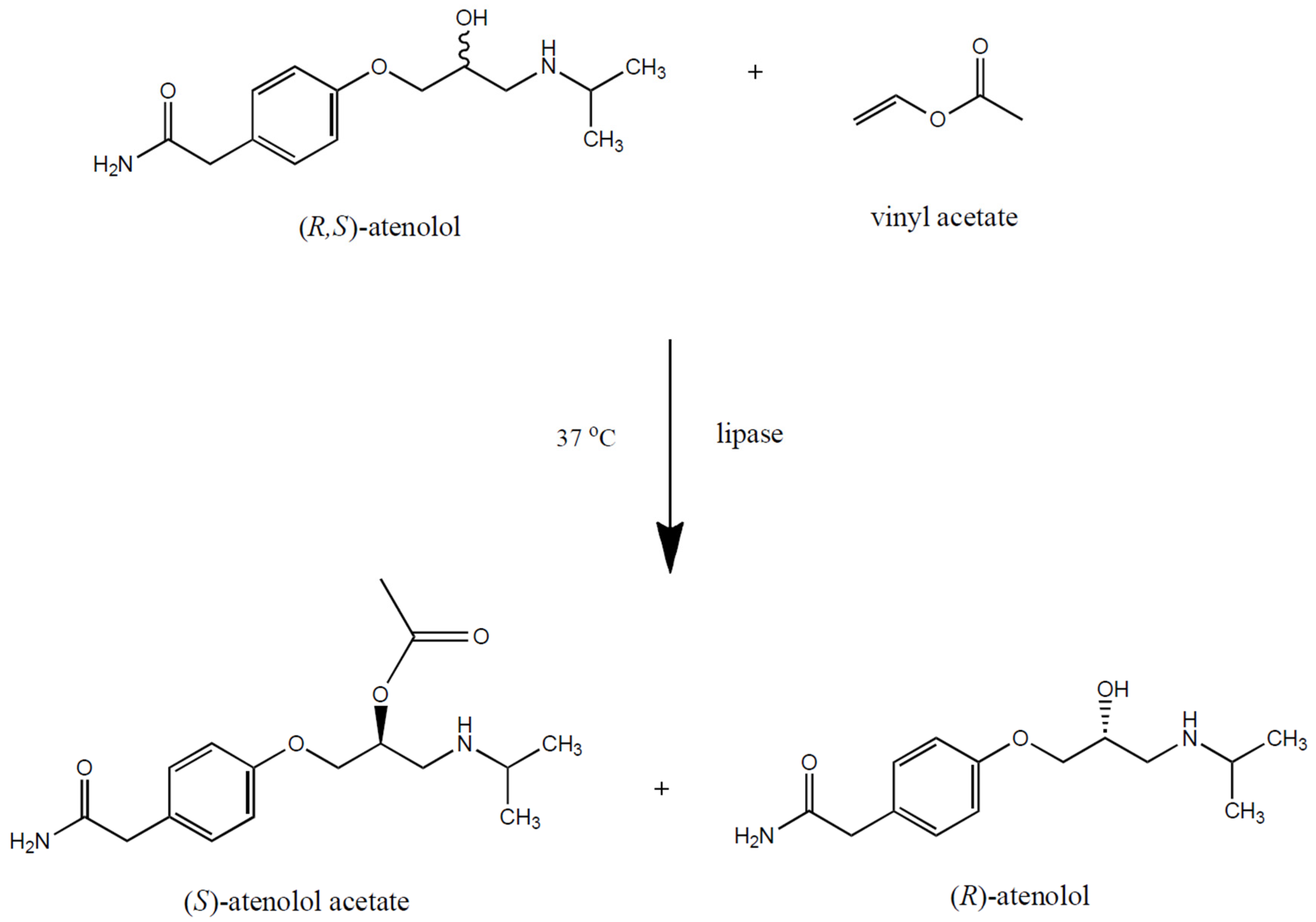
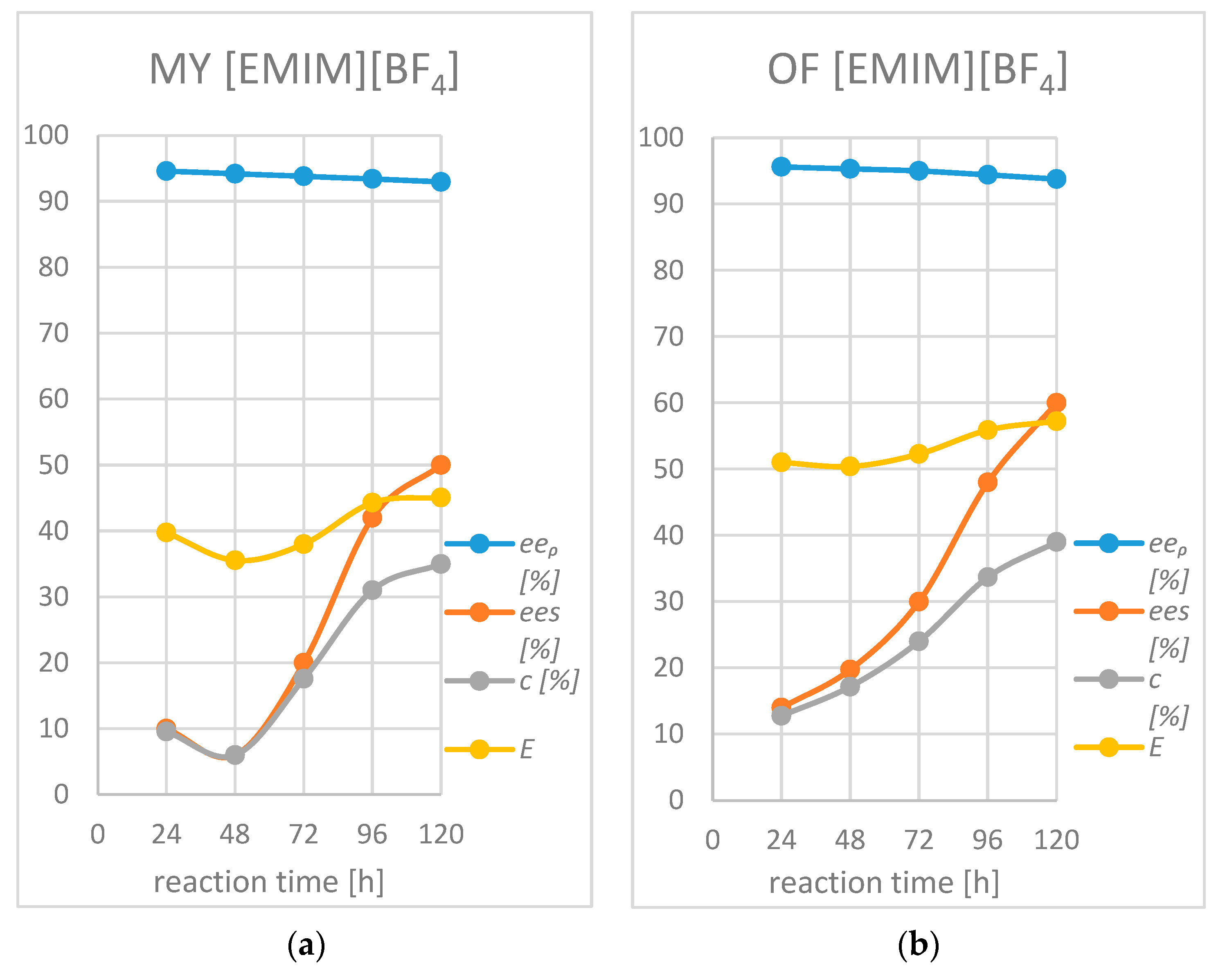
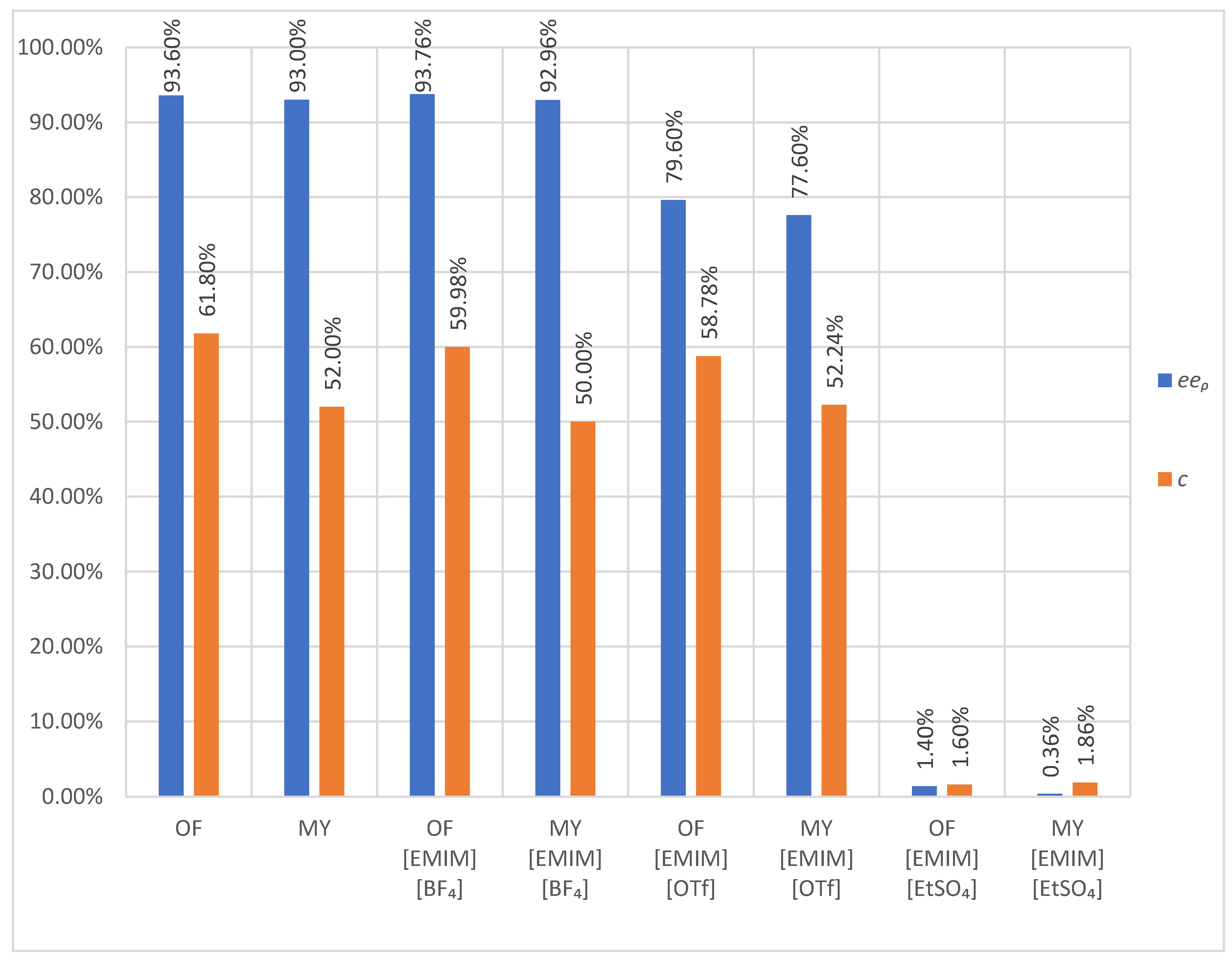

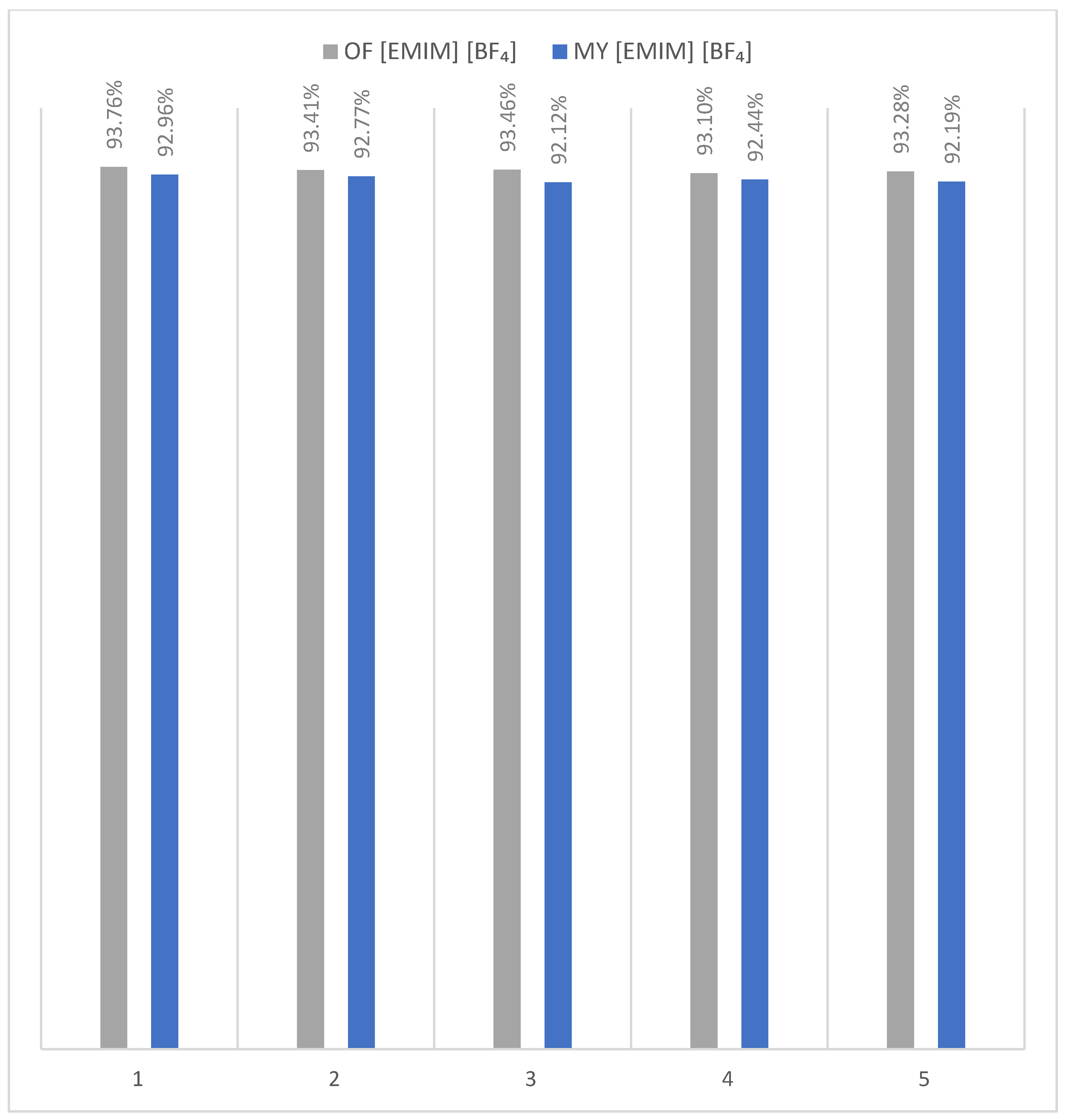

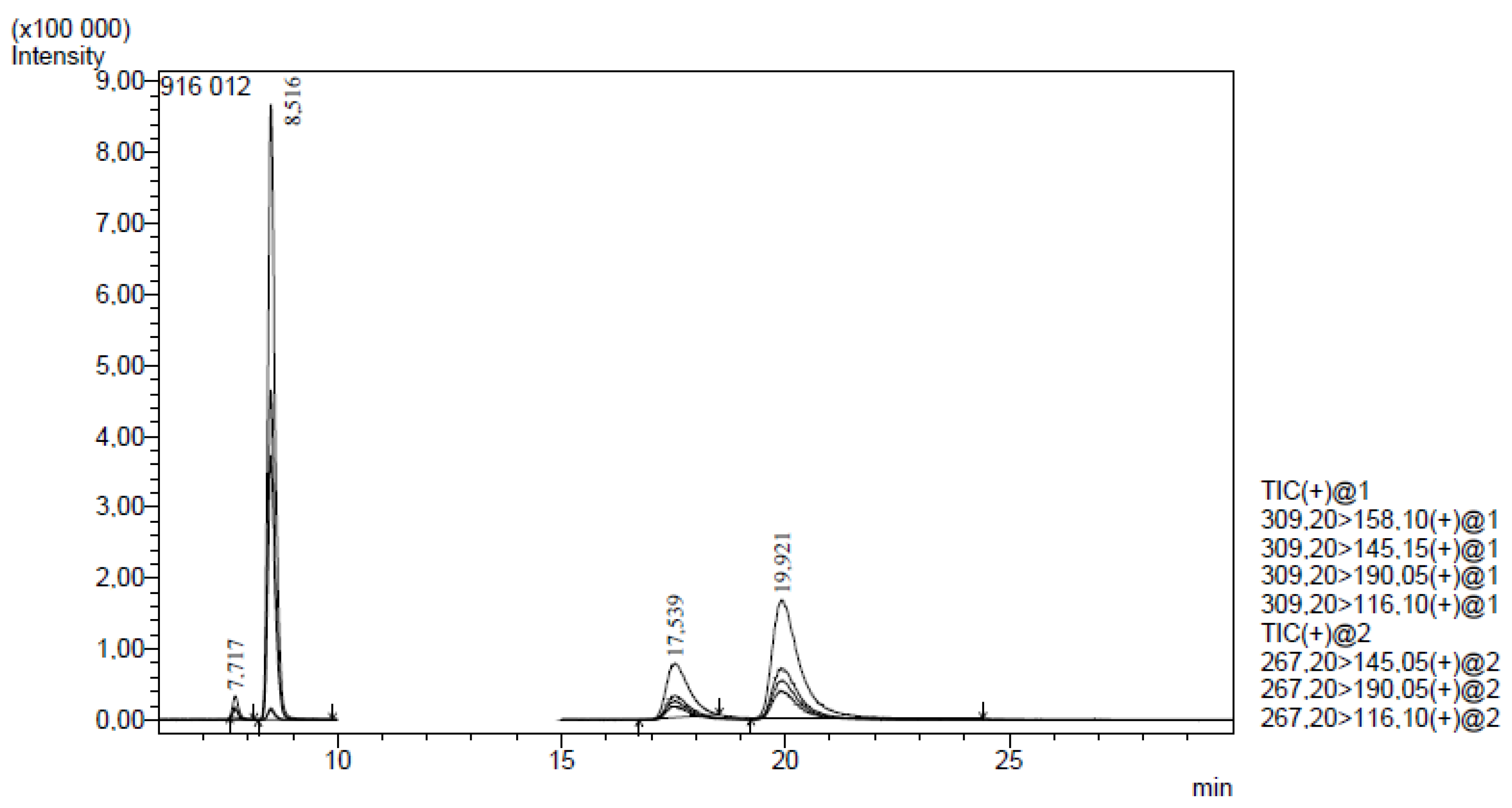
| Reaction Medium | Lipase | ees | eep | c | E |
|---|---|---|---|---|---|
| Toluene | Candida rugosa OF | 61.80% | 93.60% | 39.77% | 56.99 |
| Candida rugosa MY | 52.00% | 93.00% | 35.86% | 46.34 | |
| Toluene [EMIM] [BF4] | Candida rugosa OF | 59.98% | 93.76% | 39.01% | 57.22 |
| Candida rugosa MY | 50.00% | 92.96% | 34.97% | 45.07 | |
| Toluene [EMIM] [OTf] | Candida rugosa OF | 58.78% | 79.60% | 42.48% | 15.88 |
| Candida rugosa MY | 52.24% | 77.60% | 40.23% | 13.27 | |
| Toluene [EMIM] [EtSO4] | Candida rugosa OF | 1.60% | 1.40% | 53.30% | 1.04 |
| Candida rugosa MY | 1.86% | 0.36% | 83.89% | 1.02 |
Publisher’s Note: MDPI stays neutral with regard to jurisdictional claims in published maps and institutional affiliations. |
© 2022 by the authors. Licensee MDPI, Basel, Switzerland. This article is an open access article distributed under the terms and conditions of the Creative Commons Attribution (CC BY) license (https://creativecommons.org/licenses/by/4.0/).
Share and Cite
Chałupka, J.; Sikora, A.; Marszałł, M.P. The Utilization of Two-Phase Catalytic System in Enantioselective Biotransformation of Racemic Atenolol. Catalysts 2022, 12, 1068. https://doi.org/10.3390/catal12091068
Chałupka J, Sikora A, Marszałł MP. The Utilization of Two-Phase Catalytic System in Enantioselective Biotransformation of Racemic Atenolol. Catalysts. 2022; 12(9):1068. https://doi.org/10.3390/catal12091068
Chicago/Turabian StyleChałupka, Joanna, Adam Sikora, and Michał Piotr Marszałł. 2022. "The Utilization of Two-Phase Catalytic System in Enantioselective Biotransformation of Racemic Atenolol" Catalysts 12, no. 9: 1068. https://doi.org/10.3390/catal12091068
APA StyleChałupka, J., Sikora, A., & Marszałł, M. P. (2022). The Utilization of Two-Phase Catalytic System in Enantioselective Biotransformation of Racemic Atenolol. Catalysts, 12(9), 1068. https://doi.org/10.3390/catal12091068







